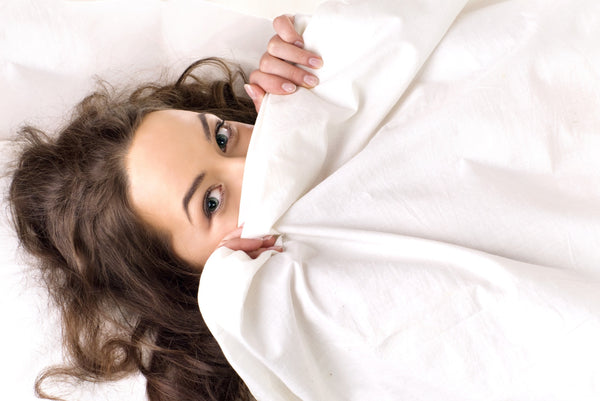How to Get Stains Out of a Mattress Cover

A mattress cover is a thin casing that goes over your mattress, similar to a fitted sheet. It's typically waterproof, or water-resistant, and protects your mattress from things like dust mites, stains, bed bugs, and more. Mattress protectors collect a lot of sweat and bacteria over time, so you'll want to clean it regularly, so it stays hygienic, and works effectively. Here is a guide for you to follow.
How Often Should You Wash a Mattress Cover
Because you put a fitted sheet over the mattress cover, you may need to wash the protector every one to two months. But, you should wash it before you use it for the first time, to soften it up, and eliminate any odors.
There are, however, some situations where you may need to wash the cover more frequently, such as:
- If you spill anything on it: If you've spilled any food or drinks on your bed, take the protector off, and wash it right away, unless it's water that you spilled. Allowing a spill to sit on your bed could cause the spill to seep into your mattress, and that will be tough to remove.
- If you or your bed partner had an illness, like a cold or flu: After your cold or flu has gone away, you'll want to wash your mattress cover to eliminate any lingering bacteria from it. This way, you'll keep your sleep surface clean, and help prevent any spreading of your illness to your family members.
- If you or a bed partner is an allergy sufferer: A dirty mattress cover may collect dander and dust mites, which could trigger allergic reactions. Ideally, you should wash your mattress cover every couple of weeks, if you suffer from allergies, to help prevent the build-up of dirt and allergens, and reduce your chances of an allergic reaction.
How to Get Stains Out of a Mattress Cover
Here are some basic steps to get stains out of your mattress protector:
Step 1: Spray a stain-remover cleaner over the stain on the mattress protector. There are eco-friendly stain removers. If it's a fresh stain, use a clean cloth to blot out the excess moisture. After you've covered the area with the spray, blot it gently with a damp cloth until the stain disappears.
Step 2: Pour a cup of vinegar into a spray bottle (empty), and spray it on the stain. Let the vinegar sit on the stain, and soak for several minutes. Now, blot some baking soda on the stain, which will cause it to bubble. Blot away the moisture with a clean cloth, and let dry.
Step 3: Pour some hydrogen peroxide (a quarter-size amount) into a cloth, and dab the stain until it's no longer visible. Don't soak the stain, however, since it could seep into your mattress.
Step 4: Take the mattress protector off the mattress, and pre-treat any stains with a stain remover. Let it sit for several minutes, and toss in your washing machine separate by itself. Check the tag on the protector for the exact temperature and washing instructions.
How to Wash a Mattress Cover
Here are some basic steps to wash your mattress cover:
- Check for open seams. Before you clean your mattress cover, you'll want to check to see if there are open seams in it. If there are, and you don't repair them, it will jam up your machine with stuffing, feathers, or other material, depending on what your cover is made of. If you can't repair it, you can always have a tailor repair it for you.
- Pretreat stains. Pretreat any stains with the detergent you're going to use, and let it soak into the stains for around 10 minutes to make it simple for the stains to come out in the wash.
- Use a front load washing machine. Front load washing machines are best for cleaning mattress covers. You'll want to check the tag on your cover first to get the right settings. Washing machines with center agitators can tear your mattress cover, and spill its contents into the machine.
- Wash on a delicate cycle. Wash your mattress cover on the delicate cycle, and set the water temperature to cool. Use a mild, gentle detergent.
- Rinse out the mattress cover twice. To ensure all the detergent is rinsed out of your mattress cover, put it through the rinse cycle twice.
- Dry your mattress cover. If you're going to dry the mattress cover, you'll want to stop the dryer every 20 minutes, and fluff it out. By not doing this, it will dry in lumps, and ruin its original smoothness.
FAQs About Mattress Protectors
Here are a few common questions you might have about your mattress covers and mattress protectors.
- What's the Difference Between a Mattress Pad and a Mattress Cover?
Buying a mattress cover or protector means you intend to preserve your investment by making sure it will not be damaged. This is completely different than a mattress pad, which is usually something you invest in to change your bed's comfort.
- Will the Mattress Cover Make My Mattress Sleep Hot?
Most mattress protectors are designed to sleep cool.
- What Should I Do if My Mattress Cover Doesn't Fit Perfectly?
The best thing about skirting material is it may look bigger right out of the package, but it shrinks to fit perfectly when you put it on your bed. You're supposed to tuck the sides into the frame or foundation, if needed. If for any reason you find it's still a little too big, just toss it in the wash and dryer.
- How Often Should You Replace Your Mattress Cover?
You should replace your cover when you start noticing worn and tattered areas, or holes, since they'll compromise its protective properties. To keep your mattress cover in shape, you can wash it with your sheets, and replace it every one to two years, or as the manufacturer recommends.
- Should I Wash a New Mattress Cover Before Placing on the Mattress?
Yes, you should give your mattress protector a wash before you place it on your mattress, since the fabric is starched for easy cutting in the production process. Washing your cover will remove the starch.
- Do Mattress Toppers Go On Top of a Mattress Cover?
The mattress cover will have to encase the surface your body comes in contact with directly. This is to protect it the same way you would if you were sleeping on your mattress. As such, the mattress cover goes on top of the latex mattress topper.
- Can You Dry Clean a Mattress Cover?
Mattress covers are simple to wash, and usually safe to put in your washing machine; however, always check the label to see the exact washing and temperature instructions. Dry cleaning mattress covers isn't recommended as the heat could harm the waterproof material.
- Should I Buy an Eco Terra Mattress Cover Today?
You can add outstanding protection and comfort to your bed and mattress with a natural latex mattress topper by Eco Terra. It's crafted with only the finest, high-quality natural latex with no fillers, no synthetics, and no chemicals. Eco-Institut and Oeko-Tex Standard certified shows its safety and purity.







